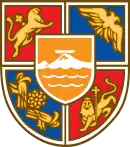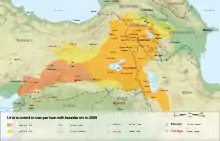Lchashen-Metsamor culture
Lchashen-Metsamor culture (Armenian: Լճաշեն-մեծամորյան մշակույթ) is an archeological culture of the Late Bronze Age and Early Iron Age (1500-700 BC) in the South Caucasus. It was mainly spread in areas of present-day Armenia.[1] Lchashen-Metsamor pottery was also found in the Agri Province of Turkey and in southern Georgia.[2]
| Geographical range | South Caucasus |
|---|---|
| Period | Late Bronze Age, Iron Age |
| Dates | circa 1,500 B.C.E. — circa 700 B.C.E. |
| Major sites | Metsamor, Lchashen |
| Preceded by | Trialeti-Vanadzor culture |
| Followed by | Etiuni, Urartu |
| History of Armenia |
|---|
 Coat of Arms of Armenia |
| Timeline • Origins • Etymology |
Description
A specific grooved pottery is associated with this culture.[3] The construction of widespread cyclopean fortresses at the end of the Bronze Age and cities,[4] indicate population growth and urbanization in the territory of Armenia.
A number of bronze items, such as bronze belts, have been discovered at Lchashen-Metsamor sites.[5] A fully preserved four-wheeled chariot was found at Lchashen.[6]
Categorization
Archaeologists have divided the Lchashen-Metsamor culture into five main stages.[7]
Late Bronze Age - LM 1,2,3
Early Iron Age - LM 4.5
The sixth stage, which arises from the local synthesis of Urartian culture, has been left out.
Identity

Archaeologists connect the Lchashen-Metsamor culture with the Etiuni tribal union attested in Urartian cuneiform.[8][9][10]
Later history
The end of the culture begins in the 8th century BC when Argishti crossed the Araks River with his army. With the appearance of Urartian culture, a syncretic Lchashen-Metsamor VI layer emerges.
Paleogenetics
An article by Damgaard (2018) dedicated to the genetic study of ancient inhabitants of the Eurasian steppes published the ancient DNA of two people from Lchashen burials. Samples included Y-DNA I2a2b-L596 and Mitochondrial DNA HV0a and J1b1a.[11]
See also
References
- McMahon, Gregory; Steadman, Sharon, eds. (2012). The Oxford Handbook of Ancient Anatolia: (10,000-323 BCE). doi:10.1093/oxfordhb/9780195376142.001.0001. ISBN 978-0-19-537614-2.
- Sagona, Antonio (2012). "Remarks on the Iron Age of Eastern Anatolia". In Çilingiroğlu, Altan; Sagona, A. G. (eds.). Anatolian Iron Ages 7: The Proceedings of the Seventh Anatolian Iron Ages Colloquium Held at Edirne, 19-24 April 2010. Peeters Press. pp. 253–268. ISBN 978-90-429-2562-5.
- Khatchadourian, Lori (2012). "The Iron Age in Eastern Anatolia". In McMahon, Gregory; Steadman, Sharon (eds.). The Oxford Handbook of Ancient Anatolia: (10,000-323 BCE). doi:10.1093/oxfordhb/9780195376142.013.0020. ISBN 978-0-19-537614-2.
- Smith, Adam T. (1 January 1999). "Late Bronze/Early Iron Age Fortresses of the Ararat and Shirak Plains, Armenia: Typological Gonsiderations". Ancient Civilizations from Scythia to Siberia. 5 (3): 73–97. doi:10.1163/157005799X00133.
- Manukyan, Sona (18 April 2015). "Bronze belts of Lchashen-Metsamor culture in the sculptures of the same period".
- Piggott, Stuart (March 1974). "Chariots in the Caucasus and in China". Antiquity. 48 (189): 16–24. doi:10.1017/S0003598X00054120.
- Avetisyan, Pavel; Bobokhyan, Arsen (2008). "The Pottery Traditions of the Armenian Middle to Late Bronze Age 'Transition' in the Context of Bronze and Iron Age Periodization". In Rubinson, Karen Sydney; Sagona, A. G (eds.). Ceramics in transitions: Chalcolithic through Iron Age in the highlands of the Southern Caucasus and Anatolia. Peeters. pp. 123–184. ISBN 978-90-429-1998-3.
- Avetisyan, Pavel; Bobokhyan, Arsen (2012). "Archaeology of Armenia in a Regional Context". In Аветисян, Паркев; Բոբոխյան, Արսեն (eds.). Archaeology of Armenia in Regional Context: Proceedings of the International Conference Dedicated to the 50th Anniversary of the Institute of Archaeology and Ethnography Held on September 15-17, 2009 in Yerevan. Gitutyun. pp. 7–20. ISBN 978-5-8080-0969-1.
- Ruzan, Mkrtchyan (2014). "The ancient population of Lchashen as a representative of the Bronze Age Armenian population". Вестник Московского университета. Серия 23. Антропология (3): 74–75.
- "Control of Capital in Urartu: Economic Resources and Movement of Commodities". The Socio-Economic Organisation of the Urartian Kingdom. 2017. pp. 28–186. doi:10.1163/9789004347595_003. ISBN 978-90-04-34759-5.
- Damgaard, Peter de Barros; Marchi, Nina; Rasmussen, Simon; Peyrot, Michaël; Renaud, Gabriel; Korneliussen, Thorfinn; Moreno-Mayar, J. Víctor; Pedersen, Mikkel Winther; Goldberg, Amy; Usmanova, Emma; Baimukhanov, Nurbol; Loman, Valeriy; Hedeager, Lotte; Pedersen, Anders Gorm; Nielsen, Kasper; Afanasiev, Gennady; Akmatov, Kunbolot; Aldashev, Almaz; Alpaslan, Ashyk; Baimbetov, Gabit; Bazaliiskii, Vladimir I.; Beisenov, Arman; Boldbaatar, Bazartseren; Boldgiv, Bazartseren; Dorzhu, Choduraa; Ellingvag, Sturla; Erdenebaatar, Diimaajav; Dajani, Rana; Dmitriev, Evgeniy; Evdokimov, Valeriy; Frei, Karin M.; Gromov, Andrey; Goryachev, Alexander; Hakonarson, Hakon; Hegay, Tatyana; Khachatryan, Zaruhi; Khaskhanov, Ruslan; Kitov, Egor; Kolbina, Alina; Kubatbek, Tabaldiev; Kukushkin, Alexey; Kukushkin, Igor; Lau, Nina; Margaryan, Ashot; Merkyte, Inga; Mertz, Ilya V.; Mertz, Viktor K.; Mijiddorj, Enkhbayar; Moiyesev, Vyacheslav; Mukhtarova, Gulmira; Nurmukhanbetov, Bekmukhanbet; Orozbekova, Z.; Panyushkina, Irina; Pieta, Karol; Smrčka, Václav; Shevnina, Irina; Logvin, Andrey; Sjögren, Karl-Göran; Štolcová, Tereza; Taravella, Angela M.; Tashbaeva, Kadicha; Tkachev, Alexander; Tulegenov, Turaly; Voyakin, Dmitriy; Yepiskoposyan, Levon; Undrakhbold, Sainbileg; Varfolomeev, Victor; Weber, Andrzej; Wilson Sayres, Melissa A.; Kradin, Nikolay; Allentoft, Morten E.; Orlando, Ludovic; Nielsen, Rasmus; Sikora, Martin; Heyer, Evelyne; Kristiansen, Kristian; Willerslev, Eske (May 2018). "137 ancient human genomes from across the Eurasian steppes". Nature. 557 (7705): 369–374. Bibcode:2018Natur.557..369D. doi:10.1038/s41586-018-0094-2. hdl:1887/3202709. PMID 29743675. S2CID 13670282.
